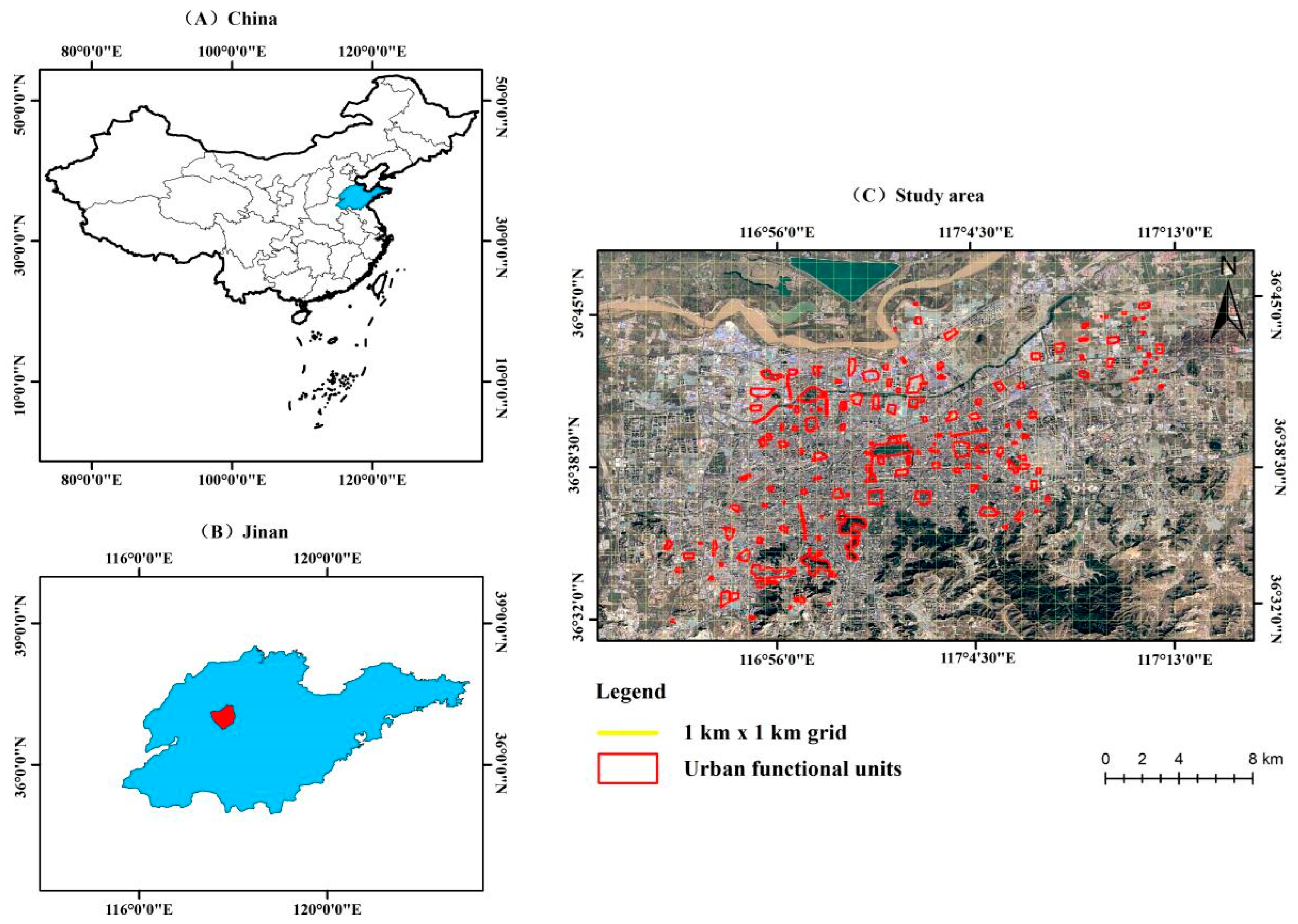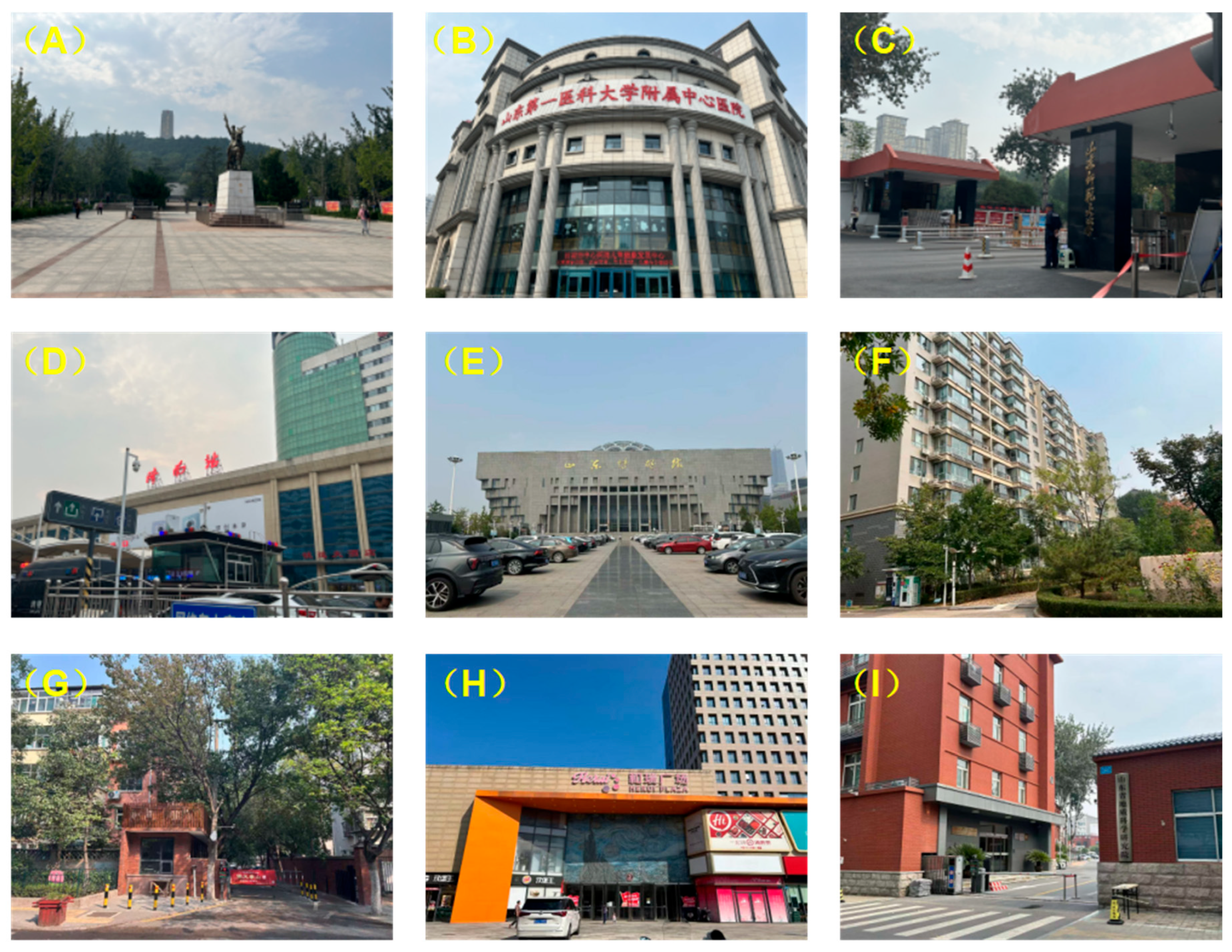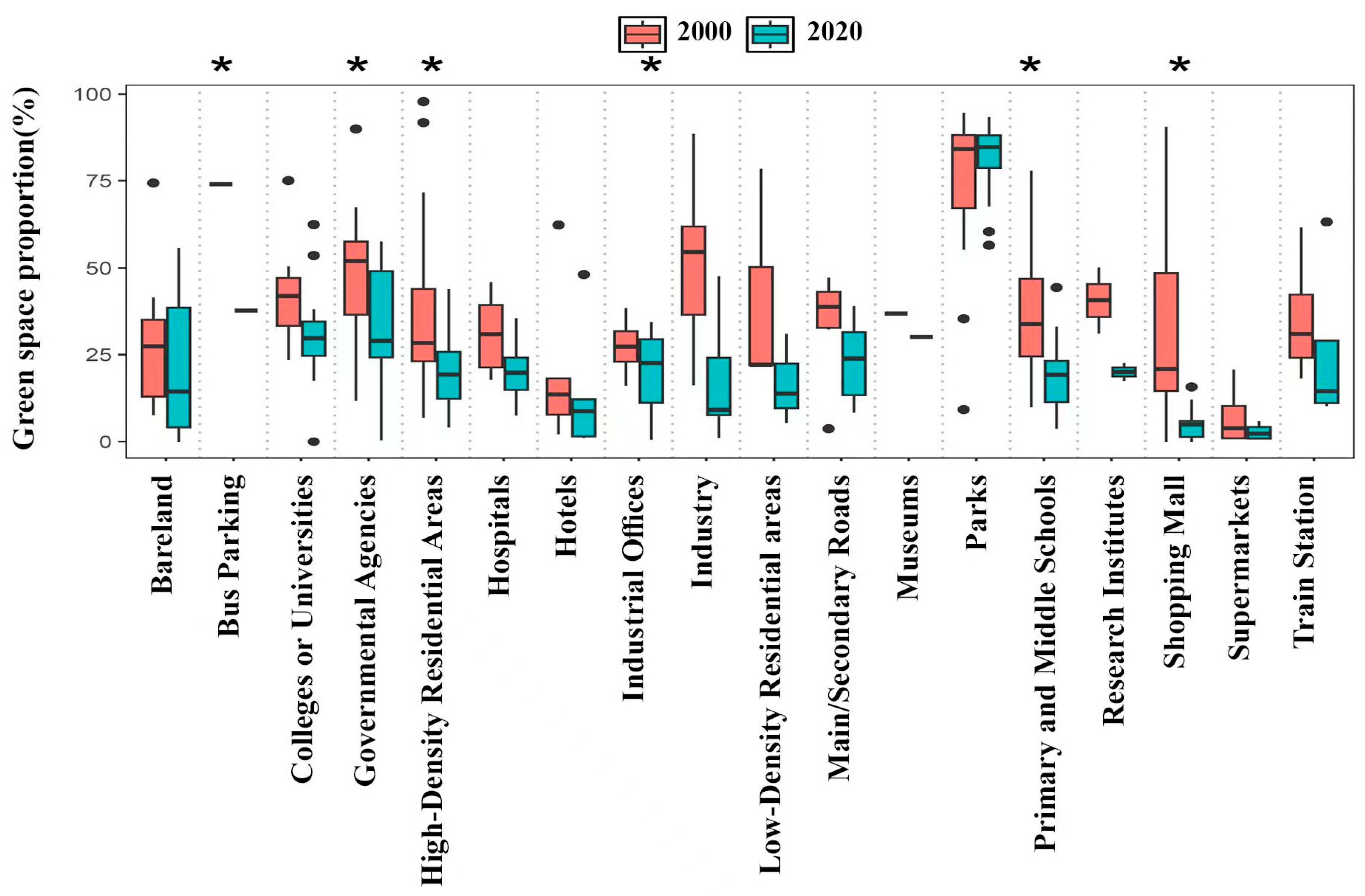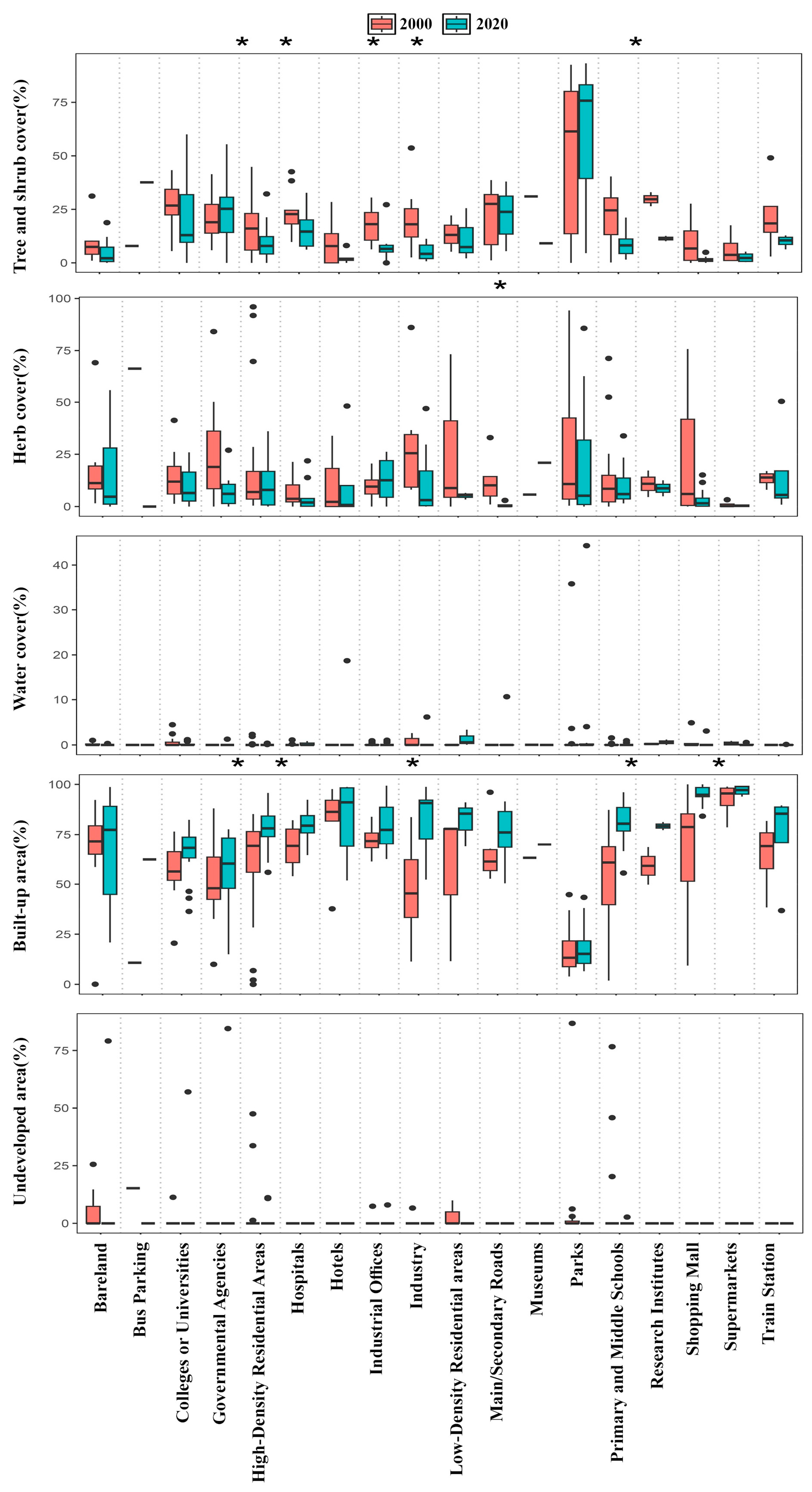4.1. Change in Land Cover in Jinan
The analysis of land cover changes from 2000 to 2020 reveals significant shifts in vegetation and built-up areas across various UFUs. Notably, parks exhibited a remarkable increase in tree and shrub coverage, growing from 56.33% to 78.09%. This expansion suggests a successful urban greening initiative, enhancing ecological benefits such as improved air quality, increased biodiversity, and enhanced recreational spaces for residents. The sustained dominance of parks in maintaining a high vegetation coverage underscores their critical role in urban planning and sustainability efforts. Urban greening, which includes increasing tree and shrub coverage in urban areas, offers a range of benefits that contribute to environmental sustainability [
14]. Increasing vegetation in urban spaces is known to improve air quality by absorbing pollutants and reducing urban heat islands, which can lead to a decrease in local temperatures and energy consumption [
15]. Additionally, well-designed green spaces like parks enhance biodiversity by providing habitats for various species and improving ecological connectivity within urban areas [
16]. The presence of trees and shrubs in urban areas also contributes to the mental and physical well-being of residents by offering recreational opportunities and enhancing their aesthetic value [
17]. Furthermore, urban greening supports sustainability efforts by mitigating the impacts of climate change through carbon sequestration and water management, contributing to the overall resilience of cities.
The rise in vegetation coverage brings a wide array of ecological, health, social, and economic benefits to the urban environment. Ecologically, urban vegetation—especially trees and shrubs—can reduce airborne pollutants by retaining particulate matter such as PM2.5 on leaf surfaces and absorbing gaseous pollutants like nitrogen dioxide and ozone, thereby significantly improving air quality. Through transpiration and shading, plants also mitigate the urban heat island effect, helping to reduce peak temperatures and the frequency of heatwaves.
The decline in tree and shrub coverage in schools and hospitals, from 25.79% to 9.74% in schools and from 25.39% to 12.73% in hospitals, is a worrying trend with potential implications for the mental health and well-being of students and patients. Numerous studies highlight the positive impact of green spaces on mental health, showing that exposure to nature can significantly reduce stress, anxiety, and depression. For example, access to natural environments has been linked to improved cognitive function and academic performance in schools, while in healthcare settings, green spaces have been found to aid in a faster recovery, reduce pain perception, and improve overall patient satisfaction. Furthermore, urbanization pressures often lead to a reduction in green spaces in favor of development, which can exacerbate mental health issues, as a lack of greenery is associated with increased stress and reduced well-being [
18]. This decline in vegetation could reflect an insufficient prioritization of natural spaces in institutional planning, which may lead to long-term negative consequences for individuals who rely on these settings for education or healthcare. Therefore, the loss of greenery in schools and hospitals not only undermines the aesthetic value of these spaces but also deprives individuals of the mental health benefits associated with nature.
The trends in herbaceous vegetation across different educational institutions highlight the evolving dynamics of urban landscapes and their impact on the built environment. Primary and secondary schools have seen an increase in herbaceous coverage, from 11.50% to 17.08%, suggesting a shift towards more green, natural environments. This increase can enhance learning spaces by improving air quality, providing restorative areas for students, and fostering a connection with nature. In contrast, universities experienced a decline in herbaceous coverage, from 16.22% to 9.25%, likely due to competing priorities in land use. As universities expand their infrastructures to accommodate larger student populations, green spaces may be sacrificed for new buildings and facilities, reflecting a trend towards more built-up environments [
19]. This disparity in herbaceous vegetation between schools and universities may thus be attributed to differences in land use priorities and available space, with schools prioritizing green spaces for educational benefit, while universities focus more on infrastructure development due to space constraints [
8].
Water coverage in urban areas tends to remain relatively stable, with parks generally maintaining the highest proportions of water features. This stability suggests that parks have successfully integrated water bodies to enhance their aesthetics and support local ecosystems, aligning with urban sustainability goals [
20]. The slight increase in water coverage within parks reflects intentional urban planning strategies, such as integrating water-sensitive urban designs to improve ecological functionality and mitigate urban heat islands. However, other urban areas, including universities, have seen minimal changes or a slight decrease in water coverage, indicating potential gaps in urban planning that could benefit from the inclusion of water features. Incorporating water-sensitive design elements, such as rain gardens and permeable surfaces, could enhance biodiversity, support mental health, and contribute to better stormwater management in these spaces. These observations underline the need for holistic urban planning approaches that integrate water features across diverse land uses to maximize ecological and social benefits.
The substantial increase in built-up areas, particularly in supermarkets and bus parking zones, reflects the ongoing trend of urbanization driven by growing commercial and transportation demands. This urban expansion caters to the logistical and economic needs of urban populations, but it also leads to the loss of natural landscapes and may contribute to environmental challenges such as the urban heat island effect. As urban areas become more built up, the prevalence of impervious surfaces increases, which exacerbates temperature rises and reduces the natural cooling capacity of the environment [
21]. This shift toward a more developed infrastructure underscores the need for cities to strike a balance between meeting the demands for economic growth and maintaining green spaces that can mitigate environmental impacts [
22]. Preserving these natural areas is essential not only for ecological reasons but also for the well-being of urban residents, as green spaces help reduce the intensity of urban heat island effects, promote biodiversity, and improve air quality. Effective urban planning strategies must therefore integrate both built infrastructure and nature to ensure sustainable, livable cities.
The significant reduction in undeveloped barren land, from 65.57% in 2000 to 15.22% in 2020, underscores the accelerating trend of urbanization. This shift toward more developed areas brings both opportunities and challenges. On one hand, urban development drives economic growth, enhances infrastructure, and meets the growing demand for housing and services. This development, however, can lead to negative environmental impacts. Urbanization often results in reduced permeability, leading to increased surface runoff, which exacerbates flooding and water quality degradation. The loss of permeable surfaces reduces the ability of natural systems to absorb water and manage stormwater runoff, making cities more vulnerable to flooding. Another consequence is the fragmentation of natural habitats, leading to a decline in biodiversity. Urban sprawl divides ecosystems into smaller patches, disrupting wildlife movement and reducing habitat availability. This fragmentation can significantly diminish species diversity and ecological resilience. To address these environmental challenges, sustainable development practices should be integrated into urban planning. Green infrastructure, including permeable pavements, green roofs, and urban wetlands, can restore some of the lost permeability, reduce runoff, and support local ecosystems. These solutions not only mitigate environmental impacts but also enhance urban resilience against extreme weather events.
4.2. Drivers of Patterns in Distribution and Amount of UGS in Jinan over the Past Two Decades
The increase in tree and shrub coverage within parks over a two-decade period underscores the significant role of urban greening initiatives in shaping urban landscapes. Among the key socio-economic factors, housing prices emerged as a consistent positive predictor of UGS distribution across both primary and secondary UFUs. This supports the “luxury effect” hypothesis, where more affluent areas possess greater access to green amenities. Construction age, particularly in residential districts, showed a negative association with UGS, indicating that older developments may lack the green infrastructure integrated into newer planning. Furthermore, land use types, particularly recreation and public service areas, were found to exert a strong positive influence on vegetation coverage. These patterns confirm that socio-economic conditions—such as wealth level, planning legacy, and functional land designation—are pivotal in determining the green space distribution in Jinan. As development pressures continue to expand built-up areas, urban planners have increasingly recognized the importance of integrating green spaces, particularly parks, into city designs. These efforts have led to a substantial rise in vegetation coverage within recreational areas, highlighting the effectiveness of land management strategies aimed at preserving and enhancing urban greenery. Studies have shown that urban greening strategies, such as increasing park vegetation, contribute significantly to mitigating heat islands, improving air quality, and fostering biodiversity in cities [
23]. Parks, with their expanding tree and shrub coverage, not only contribute to aesthetic value but also play critical roles in urban resilience. They help mitigate heat islands, conserve biodiversity, and improve overall human well-being. The increased vegetation coverage within parks reflects a broader trend in urban planning, where the need for green infrastructure is prioritized to address environmental challenges and enhance the quality of life for city dwellers [
24].
The marked reduction in tree and shrub coverage within primary and secondary schools, and to a lesser extent in hospitals, suggests a significant trade-off between infrastructure development and the retention of green space. As urban populations grow and institutional needs expand, schools and hospitals often prioritize the construction of new facilities over the preservation of natural areas [
25]. This loss of greenery has implications not only for environmental quality by reducing the benefits of urban cooling, air purification, and biodiversity but also for public health. Green spaces in educational and healthcare settings have been linked to improved academic performance, stress reduction, and faster recovery times for patients. Moreover, the diminishing presence of vegetation exacerbates the urban heat island effect, increasing energy consumption and creating heat-related health risks. Therefore, there is a clear need for policies that balance infrastructure growth with the integration of green spaces, promoting urban resilience and supporting the health and well-being of the populations that rely on these essential public services.
The shifts in herbaceous vegetation coverage across different urban spaces, such as primary and secondary schools versus universities, are influenced by varying management practices, landscaping preferences, and development priorities. Primary and secondary schools are more likely to incorporate herbaceous plants in their landscapes due to their low maintenance costs and aesthetic appeal. Additionally, these plants can serve educational purposes, providing hands-on opportunities to teach students about ecology and environmental sustainability. In contrast, universities, particularly in urban settings, often face space constraints driven by the need for infrastructure expansion. As a result, they tend to prioritize trees or hardscaping over herbaceous cover, as these options are seen as more durable and better suited for long-term use, especially in areas with high foot traffic. Despite their relatively low carbon sequestration potential compared to trees, herbaceous plants offer critical ecological benefits, including soil stabilization, pollinator support, and aesthetic enhancement. These functions are crucial in maintaining biodiversity and resilience in urban ecosystems.
Water coverage, although generally low across urban fabric use (UFU) types, shows a slight increase in parks compared to universities, indicating differing priorities when integrating water features. Parks, as public green spaces, are more likely to incorporate water bodies to improve local microclimates, enhance biodiversity, and provide recreational opportunities for urban residents. Water bodies can significantly reduce urban heat island effects by cooling surrounding areas through evaporation, making them valuable tools for mitigating the impacts of climate change in cities. Moreover, small water bodies support local biodiversity by providing habitats for aquatic species, insects, and birds, contributing to overall ecosystem health. On the other hand, universities often face challenges in integrating water features due to limited space and the high cost of maintenance. The competing demands for land and resources may make water features less feasible in university campuses, which may prioritize research facilities and student housing. Nonetheless, small water bodies, even in constrained urban settings, can still provide significant ecological and aesthetic benefits, supporting both human well-being and local wildlife. These observations highlight the need for thoughtful urban planning that prioritizes both development and ecological sustainability. By integrating herbaceous vegetation and water features into urban landscapes, cities can enhance their resilience to climate change, support biodiversity, and provide healthier, more attractive spaces for their inhabitants.
The rapid expansion of built-up spaces, particularly in commercial and transportation sectors such as supermarkets and bus parking zones, reflects broader urbanization trends driven by increasing demands for infrastructure and services. While this growth enhances economic activity and improves service accessibility, it also brings significant environmental challenges. Research indicates that the expansion of impervious surfaces in these areas exacerbates the urban heat island effect, raising temperatures and impacting local climates. Additionally, larger built environments contribute to increased stormwater runoff, overwhelming existing drainage systems and potentially leading to localized flooding and pollution. The loss of natural habitats is another major consequence, as the conversion of green spaces to urban infrastructure reduces biodiversity and disrupts local ecosystems. Thus, while the growth of built environments plays a crucial role in urban development, it also highlights the need for sustainable urban planning that mitigates its environmental impact.
The reduction in undeveloped land, particularly barren land, due to urban infill and land intensification, represents a significant shift in land-use patterns that presents both benefits and challenges. While urban infill helps optimize land use by focusing development within existing urban areas, reducing urban sprawl, and promoting sustainable growth, the conversion of barren lands, which often provide vital ecological services such as carbon sequestration and biodiversity support, may lead to environmental drawbacks. Additionally, these less-developed lands frequently serve as accessible public spaces that contribute to social cohesion and community well-being, functions that may be diminished as urbanization encroaches. As urban areas grow, it becomes critical to balance these ecological and social losses with sustainable urban planning strategies, such as integrating green infrastructure, to preserve the multifaceted benefits that barren lands provide.
4.3. Comparison of the Drivers of the Distribution of UGS in Jinan and Other Cities
The analysis of urban green space (UGS) in Jinan from 2000 to 2020 reveals several key trends in its development, reflecting both local and global urban planning dynamics. One notable trend is the positive correlation between UGS and public service districts, as evidenced by β values of 0.144 ** in 2000 and 0.115 *** in 2020. This suggests that urban planning in these areas has increasingly prioritized green spaces, especially around government buildings, civic centers, and institutions. This shift aligns with growing ecological awareness, emphasizing the integration of green spaces within public service zones. Furthermore, UGS in these areas is associated with improved community health, as studies have shown that regions with a higher green space coverage tend to experience lower disease morbidity rates, supporting the notion that well-planned green spaces in public service areas promote better public health. A study in Mumbai also observed that neighborhoods with a higher socio-economic status benefit from better access to quality green spaces, highlighting the importance of equitable urban planning, particularly in high-priority areas such as government districts.
The positive correlation between UGS and leisure areas in Jinan, increasing from β = 0.483 in 2000 to β = 0.646 in 2020, suggests an increasing focus on parks, recreational spaces, and lakeside areas, particularly near natural features such as Daming Lake. This trend mirrors findings from a study on the effects of the rapid urbanization on green spaces and well-being in Jinan, which reported a significant rise in green spaces and a corresponding improvement in residents’ quality of life. Additionally, research across major Chinese cities has shown that increased urban park space enhances both environmental quality and social interaction, further underscoring the growing importance of leisure areas in urban planning.
However, the negative correlation between UGS and built-up areas in public service zones (β = −0.392 **) in 2000 reflects the initial constraints of dense urbanization on green space expansion. This issue is common in rapidly developing cities, where urban growth often leads to the encroachment of natural areas. Studies on urban sprawl, particularly those focusing on China between 1990 and 2015, emphasize the pressure of rising land values, which often results in the prioritization of built-up areas over green space. Nevertheless, Jinan appears to have adjusted its urban planning policies over time to counteract these effects, incorporating green spaces into new developments and retrofitting older areas. As urbanization continues, the negative environmental impacts, such as rising pollution and the urban heat island effect, have prompted the further integration of green spaces into urban design as part of sustainable development strategies [
13].
The finding that UGS is positively correlated with housing prices (β = 0.124 * in 2020) is consistent with studies highlighting the economic value of green spaces. Research indicates that green areas not only improve aesthetic appeal but also enhance property values, as they contribute to a better environmental quality and neighborhood satisfaction. For example, a study in Brazil found that residents’ satisfaction was significantly influenced by the availability of green spaces, along with other amenities such as commerce and schools. Similarly, research in Medellín, Colombia, highlights how urban design features, particularly green spaces, can influence property investment and the overall attractiveness of residential areas. Further supporting this, a study on vacant land in Oklahoma City found that even potential green spaces contributed positively to housing values and urban renewal. These findings converge on the idea that UGSs serve as vital urban infrastructure, not only providing environmental benefits but also generating economic advantages by attracting investment and enhancing residents’ quality of life.
Urban areas often prioritize economic growth, sometimes at the expense of UGS, especially in areas with high land values or where local governments are focused on financial revenue from development [
16]. The loss of UGS is frequently linked to changes in land use, as observed in cities like Kolkata, where rapid urbanization has led to a significant reduction in green space [
10,
11] Similarly, the spatial distribution of UGS can be influenced by accessibility to public transportation. In Taipei, for example, UGS on vacant land and rooftops decreases as public transport accessibility improves, suggesting that urban development tends to prioritize well-connected areas [
18]. Furthermore, the urban form, including road density and built-up boundaries, often leads to fragmentation of green spaces, particularly in cities with complex layouts [
19]. Additionally, the reduction in UGS can exacerbate urban heat island effects, as seen in Bangkok, where diminished green space has led to higher land surface temperatures [
22].
In transportation zones, UGS shows a positive correlation with population density (β = 6.775 * in 2020), reflecting a trend toward integrating green spaces into densely populated transportation hubs. This helps to improve air quality and mitigate heat island effects. Jinan’s urban planning strategy, which prioritizes sustainable transport, incorporates green infrastructure such as bike lanes and tree-lined streets in transportation corridors. A study in Jinan found that increased population density tends to negatively impact access to UGS, highlighting the need for urban planning strategies that balance transportation infrastructure with an equitable green space distribution to improve sustainability and livability.
Water areas, which played a significant role in UGS in 2000 (β = 0.984), show a reduced influence by 2020 (β = 0.286). This change reflects a broader diversification of green space types, with parks and urban forests now contributing more to urban ecosystem services, including cooling, flood regulation, and aesthetic benefits. In many urban settings, the focus has shifted from relying solely on water features to improving the overall configuration of green spaces, which has proven more effective in mitigating urban heat islands.
The negative correlation between the construction age and UGS in residential areas (β = −0.116 * in 2000) highlights the challenges posed by older neighborhoods, which often have less green space than newer developments. Modern urban planning tends to integrate more green spaces, particularly in new areas, while retrofitting older areas remains a significant challenge. Studies emphasize that aging infrastructure often fails to meet the environmental and social needs of an aging population, including access to green spaces. Furthermore, newer districts tend to offer better health outcomes, partly due to the incorporation of high-quality green spaces. Research on urban green spaces in Berlin suggests that while newer districts benefit from better green space access, older areas struggle with providing equitable access due to past planning decisions. The integration of green spaces into older urban areas is essential for creating environments that accommodate a growing elderly population. The increase in the model’s R2 from 0.25 *** in 2000 to 0.52 *** in 2020 demonstrates Jinan’s evolving approach to urban sustainability. This improvement reflects a more integrated and comprehensive understanding of the role of UGS in enhancing urban livability and resilience.
Overall, our findings support the notion that the UGS distribution in Jinan reflects patterns documented in other global cities such as New York, Mumbai, and Berlin, where socio-economic disparities lead to unequal access to urban greenery. The positive associations between green space and wealthier UFUs in Jinan mirror the global “luxury effect”. Similarly, the legacy effect of earlier urban planning decisions explains the lower vegetation coverage in older districts. These parallels confirm that Jinan’s UGS dynamics are not isolated but fit within broader global urban ecological patterns.











